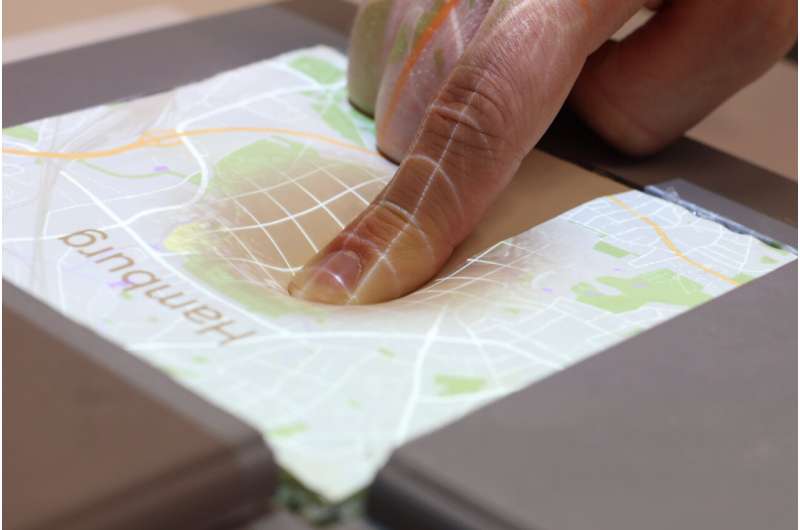
Tomorrow's digital screens may be soft and elastic, so you'll get to 'feel' items through your phone

A touch screen for digital devices that can be deformed through finger pressure, becoming softer or stiffer in direct response to force applied by the user, has been developed by computer scientists at the University of Bath in the UK.
DeformIO—as it has been named—is still a prototype and will require at least a decade of further development before it can be passed on to tech companies to be shaped into a commercial product; however, its inventors regard it as groundbreaking technology.
They believe DeformIO has the potential to radically change the way people interact with the world in fields as diverse as commerce, communications, medicine and gaming.
Before making an online purchase, for instance, the shopper of tomorrow may be invited to "touch" the fabric of a new sofa or "feel" the softness of a pillow simply by pressing on their DeformIO phone display.
The deformable screen also has the potential to change the way users interact with files and apps on their devices. To delete a file, for instance, a person may find themselves pushing on the file icon until it stiffens and eventually "pops" like a bubble.
"You'd be directly manipulating a digital object the way you normally would a physical one," explained James Nash, a computer-science postgraduate at Bath and first author of a study describing the new technology, published this month.
Pinning down the display
Though this is not the first iteration of a deformable display, earlier models (made from movable touchscreen panels or rigid pins) have created a less continuous experience than DeformIO, relying on arrays of raised "pins" lying beneath the display which, when depressed, lowered a section of screen. Such technology results in sharp breaks or steps between areas of the screen when pressure is applied.
DeformIO, which is made of silicone, works in an entirely new way, using pneumatics and resistive sensing (a technique that transforms physical forces into electric signals) to detect pressure.
With this technology, a user can depress the screen then run their finger across the surface to create a natural, continuous movement.
"Our screen allows users to perceive rich tactile feedback on a soft surface," said Mr. Nash.
"It gives the same benefits as today's glass-based screens—which allow you to control your device by moving your finger fluidly across the surface—but with the added benefit of a person being able to use force to interact with their device at a deeper level."
Another feature of the DeformIO is that it allows a user to apply forces to multiple areas on a screen simultaneously, with the display being able to distinguish between levels of pressure applied, creating degrees of softness appropriate to the force detected.
University of Bath computer scientist Professor Jason Alexander, who has been working on deformable screens for the past 10 years and is leading the research on DeformIO, says the 25cm x 25cm prototype developed in his lab has been built, "to explore a vision of devices with screens that you can push through and they can push back."
He said, "We hope that in 10 to 20 years' time, the concepts it embodies could be in your mobile phone. For now, we're exploring the applications it might be best suited to."
More information: James David Nash et al, DeformIO: Dynamic Stiffness Control on a Deformable Force-sensing Display, Extended Abstracts of the CHI Conference on Human Factors in Computing Systems (2024). DOI: 10.1145/3613905.3650772
Citation: Tomorrow's digital screens may be soft and elastic, so you'll get to 'feel' items through your phone (2024, May 28) retrieved 10 June 2024 from https://techxplore.com/news/2024-05-tomorrow-digital-screens-soft-elastic.html
This document is subject to copyright. Apart from any fair dealing for the purpose of private study or research, no part may be reproduced without the written permission. The content is provided for information purposes only.